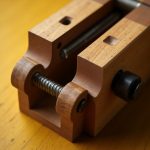```
What Happened in the Shop?
The incident involved a table saw kickback—a term that sends shivers down the spine of any seasoned woodworker. A strip of wood shot through the wall behind the saw, penetrating two layers of drywall between the studs and sticking out into the finishing room. Imagine if it had hit a person. Fortunately, no one was hurt, but the event was a wake-up call for everyone involved.
This happened while making a bevel cut. At first glance, everything seemed to be in order. The blade guard wasn’t on, but it was impossible to use it with the fence in that position. A riving knife, an essential anti-kickback device, was installed but didn’t prevent the kickback, which occurred at the front of the blade. So, what went wrong?
The Mechanics of a Kickback
Here’s the breakdown: The pusher (a tool used to guide the workpiece) moved the wood forward, but the offcut stayed next to the blade. When the pusher was used to draw the workpiece away from the fence at the end of the cut, it nudged the leading end of the offcut to the left. This turned the trailing end toward the blade, where it was caught by a front tooth and ejected in about 1/30th of a second. That’s faster than you can blink.
Why Did This Happen?
Kickbacks are often caused by a combination of factors. In this case, the position of the fence, the absence of a blade guard, and the mechanics of the cut itself played a role. But the big takeaway? Even with safety devices like a riving knife, accidents can happen if the setup isn’t perfect.
The Role of Riving Knives and Blade Guards
A riving knife is a lifesaver—literally. It shields the back of the blade, where most kickbacks originate. But as this incident shows, it’s not foolproof. The best piece of safety technology ever invented for a table saw is still the blade guard. Yet, many woodworkers remove it because it’s “in the way.” Sound familiar?
Stumpy Nubs points out that some modern saws have adjustable fences, allowing you to use the blade guard even with the fence closer to the blade. If your saw has this feature, use it. If not, consider upgrading. Safety is worth every penny.
How to Avoid Kickbacks
So, how do you protect yourself? Here are three key strategies:
- Follow Through: At the end of your cut, push the workpiece fully clear of everything. Don’t stop halfway.
- Use a Wide Push Block: When ripping narrow strips, a wide push block can give you better control. Stumpy Nubs even shared a homemade version that’s both effective and easy to make.
- Raise the Blade Higher: Adjust the blade so the teeth at the front move in a downward direction, reducing the risk of the offcut being caught and ejected toward you.
Thought Experiments: What If?
What if the saw had an adjustable fence? What if the blade guard had been in place? What if the operator had used a wider push block? Small changes can make a huge difference. Think about how you can tweak your setup to prioritize safety.
The Bigger Picture: Safety in Woodworking
This incident isn’t just about one kickback—it’s about the culture of safety in woodworking. Too often, we prioritize convenience over caution. We skip steps, remove guards, and take risks because “it’s just one cut.” But as this story shows, that mindset can have serious consequences.
Stumpy Nubs’ channel is a treasure trove of woodworking knowledge, and this video is a must-watch for anyone who uses a table saw. Check it out below for a visual breakdown of the incident and more tips on staying safe.
Want more woodworking plans and tips? Check out Ted’s Woodworking Plans, a comprehensive resource for woodworkers of all skill levels.
Conclusion: Safety First, Always
Woodworking is a rewarding hobby, but it’s not
Disclaimer: This article may contain affiliate links. If you click on these links and make a purchase, we may receive a commission at no additional cost to you. Our recommendations and reviews are always independent and objective, aiming to provide you with the best information and resources.
Get Exclusive Stories, Photos, Art & Offers - Subscribe Today!

























Post Comment
You must be logged in to post a comment.